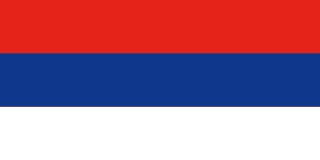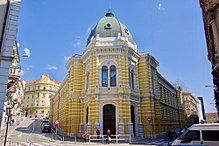
The demographic characteristics of the population of Croatia are known through censuses, normally conducted in ten-year intervals and analysed by various statistical bureaus since the 1850s. The Croatian Bureau of Statistics has performed this task since the 1990s. The latest census in Croatia was performed in autumn of 2021. According to final results published on 22 September 2022 the permanent population of Croatia at the 2021 census had reached 3.87 million. The population density is 68.7 inhabitants per square kilometre, and the overall life expectancy in Croatia at birth was 78,2 years in 2018. The population rose steadily from 2.1 million in 1857 until 1991, when it peaked at 4.7 million. Since 1991, Croatia's death rate has continuously exceeded its birth rate; the natural growth rate of the population is negative. Croatia is in the fourth stage of the demographic transition. In terms of age structure, the population is dominated by the 15 to 64 year‑old segment. The median age of the population is 43.4, and the gender ratio of the total population is 0.93 males per 1 female.

Sisak-Moslavina County is a Croatian county in eastern Central Croatia and southwestern Slavonia. It is named after the city of Sisak and the region Moslavina just across the river Sava. According to 2021 census it is inhabited by 141,000 people.

Vukovar-Srijem County, Vukovar-Sirmium County or Vukovar-Syrmia County, named after the eponymous town of Vukovar and the region of Syrmia, is the easternmost Croatian county. It includes the eastern parts of the region of Slavonia and the western parts of the region of Syrmia, as well as the lower Sava river basin, Posavina and Danube river basin Podunavlje. Due to the overlapping definitions of geographic regions, division on Slavonia and Syrmia approximately divides the county vertically into north-west and south-east half, while division on Posavina and Podunavlje divides it horizontally on north-east and south-west half.

Borovo, also known as Borovo Selo, is a village and a municipality in Vukovar-Syrmia County in eastern part of Croatia. Situated on the banks of the Danube river, it shares its border with Serbia and the municipality of Bač on the opposite side. The historical development of Borovo is intricately linked with the Danube, which has played a pivotal role in its development as a notable industrial hub in the region.

The Serbs of Croatia or Croatian Serbs constitute the largest national minority in Croatia. The community is predominantly Eastern Orthodox Christian by religion, as opposed to the Croats who are Catholic.
Languages of Yugoslavia are all languages spoken in former Yugoslavia. They are mainly Indo-European languages and dialects, namely dominant South Slavic varieties as well as Albanian, Aromanian, Bulgarian, Czech, German, Italian, Venetian, Balkan Romani, Romanian, Pannonian Rusyn, Slovak and Ukrainian languages. There are also pockets where varieties of non-Indo-European languages, such as those of Hungarian and Turkish, are spoken.

Negoslavci is a village and a municipality in Vukovar-Syrmia County in eastern Croatia. It is located south of the town of Vukovar, seat of the county. Landscape of the Negoslavci Municipality is marked by the Pannonian Basin plains and agricultural fields of maize, wheat, common sunflower and sugar beet.
Lipovljani is a municipality in Croatian Slavonia in the Sisak-Moslavina County.

Croatia–Ukraine relations are foreign relations between Croatia and Ukraine. The countries established diplomatic relations on 18 February 1992. Croatia has an embassy in Kyiv and an honorary consulate in Donetsk. Ukraine has an embassy in Zagreb and honorary consulates in Malinska and Split. Croatia supports Ukraine's European Union and NATO membership.

Pačetin is a village in the municipality of Trpinja, Vukovar-Syrmia County in the easternmost part of Croatia. At the time of the 2011 Census the population of the village was 541. Village lies north of the Vuka River and west of the M601 railway. Its major landmark is the Church of St. Nicholas from the 18th century. County road Ž4111 passing through the villages of Pačetin, Bobota and Vera connect all three villages with D2 road and D55 road. Pačetin is 28.6 km southeast of Osijek, the economic and cultural centre of Slavonia and 17.2 km from the Osijek Airport. County seat Vukovar is 17.3 km east of Pačetin.

The Serbian Cultural Society "Prosvjeta" in Zagreb, Croatia, is an independent, non-governmental cultural and scientific organization that takes special responsibility for promoting culture of and among Serbs in Croatia. Its primary aim is preservation and development of national identity of Serbs in Croatia.

The Association for Serbian language and literature in Croatia is a non-profit professional organization that brings together scientists and technical workers engaged in studying and teaching of Serbian language and literature in Croatia. The association operates throughout Croatia and its headquarters are located in Vukovar. The association was established in 1998, after the completion of the UNTAES mission in the region, with ambition to work on protection of the Serbian language and the literature of Serbs in Croatia, engage in the study of the history and culture of the Serb people in Croatia, and present its cultural heritage.

Slovaks are one of the recognized autochthonous minorities of Croatia. According to 2011 census, there were 4,753 Slovaks in the country.

The Serbs of Zagreb are a traditional minority group that lives in the Croatian capital Zagreb.

The Anti-Cyrillic protests in Croatia were a series of serbophobic protests in late 2013 against the application of bilingualism in Vukovar, whereby Serbian and the Serbian Cyrillic alphabet were assigned co-official status due to the local minority population. The implementation of this decision became mandatory after the 2011 Croatian census, according to which Serbs in Vukovar comprise more than one-third (34.8%) of Vukovar's total population. Signs in the Serbian Cyrillic alphabet had been put up as the Constitutional Act on the Rights of National Minorities mandates bilingual signs in any area where more than one-third of the population belongs to an ethnic minority. This decision became subject of intense agitation by, among others, Croatian war veterans and many ordinary citizens who believe that due to events, particularly the Battle of Vukovar, the city should have been excluded from the application of the law on minority rights, although protests and vandalism have occurred in other towns and cities. The Serbs of Croatia are a minority group that have the narrowest usage of right to bilingualism among all national minorities in Croatia.

The Serbs of Vukovar are one of traditional communities living in the multicultural, multi-ethnic and multi-confessional eastern Croatian town of Vukovar on the border with Serbia. The Serb community constitutes slightly over one third of the entire population of Vukovar according to 2011 Census. Other significant communities include the Croat majority, as well as Hungarians, Slovaks, Rusyns, Ukrainians and historically Yugoslavs, Germans, Jews, Vlachs and Turks.
The Serbian language is one of the officially recognized minority languages in Croatia. It is primarily used by the Serbs of Croatia. The Croatian Constitution, Croatian Constitutional law on national minorities rights, Law on Education in Language and Script of National Minorities and Law on Use of Languages and Scripts of National Minorities define the public co-official usage of Serbian in Croatia. Serbian and Croatian are two standardized varieties of the pluricentric Serbo-Croatian language. The majority of Serbs of Croatia use Ijekavian pronunciation of Proto-Slavic vowel jat except in the Podunavlje region in Vukovar-Syrmia and Osijek-Baranja Counties where local Serb population use Ekavian pronunciation. Post-World War II and Croatian War of Independence settlers in Podunavlje which have come from Bosnia, Dalmatia or Western Slavonia either use their original Ijekavian pronunciation, adopted Ekavian pronunciation or both of them depending on context. In 2011 Census majority of Serbs of Croatia declared Croatian standardized variety as their first language with Ijekavian pronunciation always being required standard form in Croatian. While Serbian variety recognizes both pronunciations as standard, Ekavian is the more common one as it is the dominant one in Serbia, with Ijekavian being dominant in Bosnia-Herzegovina, Montenegro and Croatia.
The ethnic groups in Yugoslavia were grouped into constitutive peoples and minorities.

The Croatian Romani Union "Kali Sara" is an political and self-government organization of the Romani people in Croatia. Its seat is located in Croatian capital city of Zagreb.
The various regional and minority languages in Europe encompass four categories:




















